Recover Lost Password | Register
 Team info: Team info:
Racing for Holland
Tamar Nelwan
Amsterdam
 Netherlands Netherlands
 Participated in: Participated in:
Kyosho 1/28 Group C R#3, 2011
Kyosho 1/28 Group C R#2, 2011
Le Mans Legends @ Spa Francorchamps, 2008
The Vikings 12 hours, 2007
FIA/GT Spa Francorchamps, 2007
GT endurance, 2007
12hrs GT Norway, 2007
LMS R4 LMP/GT, 2006
LMS R3 Blue King 24hrs, 2006
LMS R5 LMP/GT, 2004
EPC 2004 (Le Mans), 2004
LMS R2 Blue King 24hrs, 2004
EPC 2003 (Le Mans), 2003
 All Teams All Teams
|


Formed in 2001, RfH (Racing for Holland) was the banner under which the Amsterdam based slotrace club Hot Slot took its first steps in the international 124 modelcar scene. Drawing inspiration from Dutch racing guru Jan Lammers, the slot team started taking part in Endurance races with LMP cars like the RfH Lola BK98 and the RfH Dome S101.
Always trying to build cars that maintain the link between motorsport and slotracing, RfH has taken podium finishes in many international events and has over the years become a household name in 1/24 Modelcar Endurance racing.
Core members of the RfH team are: Tamar Nelwan, Nick de Wachter, Gabriel Inäbnit and Willem Kloppenburg. 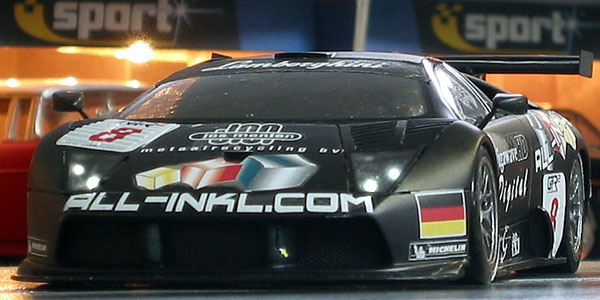 Latest entry of the team was at the Spa FIA/GT Double with the awesome #8 Lamborghini Murcielago R-GT. Loosing 17 laps after the Lambo shed a pinion early in the race, the team chased the Bad Boys Maserati all the way to the finish. In the end the gap was still 9 laps, but 2nd place was no reason to spoil the Birthday celebrations! Latest entry of the team was at the Spa FIA/GT Double with the awesome #8 Lamborghini Murcielago R-GT. Loosing 17 laps after the Lambo shed a pinion early in the race, the team chased the Bad Boys Maserati all the way to the finish. In the end the gap was still 9 laps, but 2nd place was no reason to spoil the Birthday celebrations! 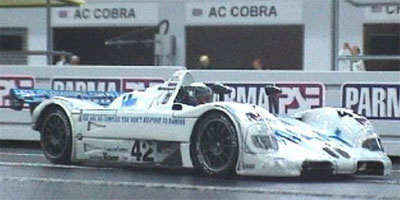 2001: BMW V12LMR Art Car 2001: BMW V12LMR Art Car
The first time RfH took part in a slotrace competition was at the Deutsche Plafit championships in 2001. Tamar Nelwan, Gerhard Brethouwer and a very young Nick de Wachter making the trip to Morfelden. During free practice the car showed great promise and was right on the pace. Unfortunately Jenny Holzger's text "Protect me from what I want" got a different meaning when a slight misreading of the rules prevented the car from entering the race, the team burning midnight oil preparing a hastly aquired Panoz GTR instead.
Merely one week later the Art car revenged itself, this time Marcel Oosterling replaced Nick in the BMW which scored its first international result by finishing 5th in the European Plafit Championship race in Igualada, Spain. The car was only raced once more in the opening round of the 2002 LMS series at Sint Niklaas, Belgium, finishing second behind a similar but faster BMW of De Vries Racing.
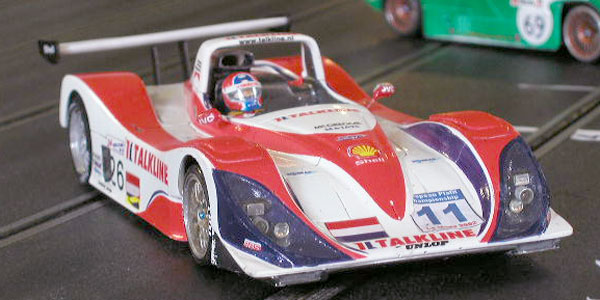 2002: Lola BK98 2002: Lola BK98
The first "real" RfH car, modelled after the 1999 entry for LM 24hrs. Competitors in their "own" LMS series, Philip de Vries and Tamar Nelwan joined hands during the international events. Combining the magic mechanical touch of the "Wizzard" with inspired driving of Gerhard "Brett" Brethouwer and Tama, gave the car a maiden win in the 2002 the EPC race at Le Mans, France. Only 2 weeks after Le Mans the newly crowned "European Plafit Champion Team" was victorious again. For the Belgium Speedlines 24hrs, local drivers Dieter Goosens en Tom van Leeckwijk joined Philip and Tamar.
A hobbled start (loosing a wheel after 5 laps) meant the team had to chase down the leaders, but such was the pace of the Lola that when it took the lead by midnight and won the race later with more than 10% margin on the second placed home team.
2002: RfH Dome S101.
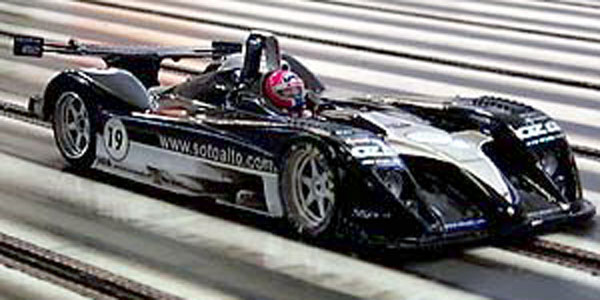 The first of RfH Dome's. Although it had won both races it had entered Philip de Vries was not satisfied with the "brick like" performance of the Lola. For the 2002 DPM he wanted something lower and longer...enter the RfH Dome. A laminated GFK body was sourced from Harald Uhl, but it needed some major modifications to fit the big Plafit Bison MK III under its low sleek lines. Not beeing able to get the "checkered flag" decals the S101 was painted in FIA WSC colors. The first of RfH Dome's. Although it had won both races it had entered Philip de Vries was not satisfied with the "brick like" performance of the Lola. For the 2002 DPM he wanted something lower and longer...enter the RfH Dome. A laminated GFK body was sourced from Harald Uhl, but it needed some major modifications to fit the big Plafit Bison MK III under its low sleek lines. Not beeing able to get the "checkered flag" decals the S101 was painted in FIA WSC colors.
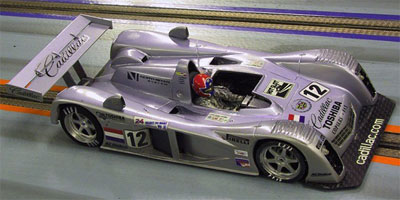
2003: Caddillac North Star LMP
2003 was the first year the RfH name was also used in the Dutch LMS series, although here it was said to mean "Racing for Hotslot . Nick de Wachter rejoined the team as chief mechanic and the Caddy was his first attempt to challenge the technical dominance of 2002 LMS champ Philip de Vries. Weeks of labour were almost destroyed when the body suffered a near total melt down as Tamar used an hot air oven to quick dry the last layer of clear coat.
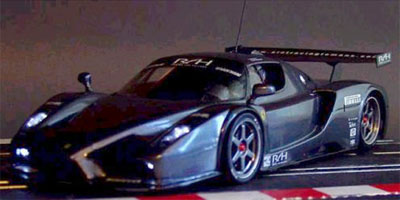
2004: The late night Enzo.
Every february Mathias Parke and co organise a semi-endurance at their Renncenter Hamburg. Technical rules more or less being like the old LMS. Racing for Holland was initially to late to enter the race and was put on a waiting list for months. So RFH almost forgot about the whole race, on monday the phone rang; if we'd please enter 'cause another team couldn't show. This was the beginning of a 5-day-marathon, to get this car built from the ground up, hence it 'carbonfibre' livery, no time to put more decals on :)
As up to this day there are no official Enzo's prepared for competition, so Tamar Nelwan gave it its own interpretation of how an Enzo would look if it would race. He widened the car and added an airscoop for the V12.
The race: first drama. As soon as the team arrived and unpacked, the wheels and controllers where missing. Nick de Wachter had accindentally left them in Amsterdam. Training went no better, as the car handled reasonably, it had an uncurable 'jutter'. It just kept making a hidious noice under braking.
Willem Kloppenburg and Gabriel Inabnit met with Henry van Gool halfway to Hamburg to pick up the wheels and controllers in the night, and Tamar and Nick went to the hotel where Nick filled a complete trashcan with nosetisseus as he had a terrible cold.
Tamar and Nick spent all night reglueing the body to try and solve the jutter-problem.
It helped, the jutter was gone and the car was ok. But that's all it was. The car never got any better than ok so all the rather sleepy team could do was acquiring a meagre 5th place.
2004: The Toyota GT-One
Racing for Holland only drove this car once, at the 2004 LMS teamrace at SRC Niederrhein. Team mechanic Nick de Wachter had been making lots of Toyo's in the past, for fun and for customers. But this time he really wanted to show what the sleek Janapese was capable of. Weeks of testing were put in and the car was blindingly fast, on the RFH home track with lots of grip. Times were matching the pace of the championship leading BMW of Philip de Vries.
Electronics experts Gabriel Inabnit did a fantastic job, lighting up the number shields on the side of the car.
All teams were struggeling to find grip on the normally only "Orthmann tyre" track. The race had a fantastic last heat, as RFH managed to overtake the BMW and the Matchbox customer Audi R8 did the same, only to fall back into second place in the last 20 seconds.
It was the first ever victory for RFH over Philip de Vries and marked the turning point in his LMS technical domination.
2004: Dome S101 III
This car has confirmed Racing for Holland's place on the international slotrace map and therefore deserves a longer story.
For Tamar Nelwan this was his third Dome, and wanted to make this 'the one'. The team was on a winning streak and put all their efforts in creating what would be their best Dome yet. During the building process Nick de Wachter had managed to find a spot in the 1/1 Racing for Holland team, and could provide Tamar with the latest changes the car underwent before heading to Le Mans.
The 1/24 Dome chassis was a first for Nick, as this was his first attempt to make the chassis as rigid as possible.
He spent two(!) months tighening the two screws on the springsteel excell so they wouldn't be loaded with tension but still making the chassis completely stiff. Then another month was taken to let the chassis do "roling sessions' on a flat surface floor at Nick's home, using a LEGO device to shoot the chassis over the floor with the same power, so Nick could perfect it's rollresistance.
Meanwhile Tamar drawed all the 293 sponsorblocks, helped by Nick's presence in the 1/1 workshop. Tamar created a work of art as far as the body went, and as always Gabriel Inabnit's work was perfect. The car had it's charastaristic centerlights and just beatifull overall lights.
The best teamwork so far made this Dome come together in the days before it's first of many different races, it's first being another 24hrs of Uden, where the car was fastest out of the box. The superb allignment made sure the car was the fastest on the straights, and there's no easier spot to overtake then on the straight! This was the second victory over Philip de Vries and his new Audi R8.
Two weeks later the car took part in the EPC at Le Mans, where Nick was working on the 1/1 Dome, but managed to take part in the 1/24 race cause this was held on Friday and the 1/1 teams have a day off on that Friday! The 1/24 Dome came in second after a grueling combat with Martin Bartelmes' team.
This Dome went on to race for another 1,5 years, winning countless podium finishes and still is one the most established links between Racing for Holland 1/24 and Racing for Holland.
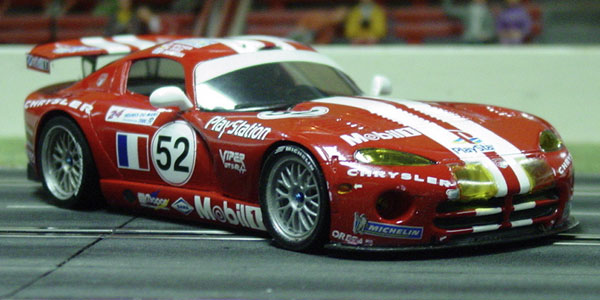 2004: The "hated" Dodge Viper
KUTVIPER! 2004: The "hated" Dodge Viper
KUTVIPER!
That was the general discription team mechanic Nick de Wachter gave the Viper after its first roll-out session. Having raced the Dome's in the past the team was in for something new, in both car and challenge. Tamar Nelwan had always wanted to race a Viper, so he started what would turn out to be a months-long project in creating a true racing Viper, meeting the dimensions it would need in 1/24. As in real GT, this Viper stood at the beginning of a new era; one of sofisticated, big-balled GT's.
Concidering the opposition Racing for Holland aimed for a top 3 place, but soon after testing began the team hoped for a top 5 spot, 'cause especially the old De Vries BMW and the (ex RFH) Matchbox Toyota GT One where clocking times a mere half a second a lap faster than the Viper. But all this couldn't hurt Tamars good spirits; he wanting to win the race because: Gabriel Inabnit made awesome frontlight, which illuminated whichever corner the Viper took.
Big upset came when after day 1 the Viper was leading the race, half a lap in front of the Friesian home team. All the other LMP's had trouble keeping their parts on the cars and had dropped back. Sunday afternoon the Viper came in first, but the LMP's had been catching up fast and surely would have won if the race would last one minute longer. All this still couldn't convince Nick; he still calls it kutviper!
2005: "Dorien"
The Racing for Holland Ferrari 333 SP was a pure purpose-built car. Always being short on time RFH needed to build a car in one week that could take part in the 24hrs of Uden and the 24hrs of Speedlines the very next week after the first mentioned race. Choice fell on the 333. Not only was it easier to build but also at the Speedlines race you can use a spurwidth as wide as your body, and as the 333 of BBR Models happened to be 86,5mm wide front and rear, the choice was obvious.
"She" soon had a name. During the 2004 edition of the 24hrs of Speedlines Tamar Nelwan and Nick de Wachter had to cover half of the race with just the two of them and had therefore acquired some adult 'reading material' to keep them awake. One of the "chapters" caught their imagination and stuck with them for a year, and for reasons not needing explanation the 333's proportions were kind of, well, let's say, "similar".
The car had a cautious race at the first 24hrs at Uden and came in second, 3 laps down on the winners and a week later RFH drove "Dorien" to a glorieus win, after having many problems and hick ups and only came into the lead 20 minutes before the end of the 24 hours.
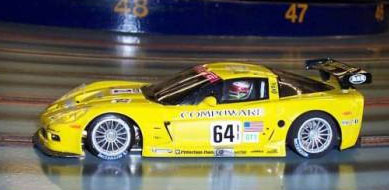 2005: The lovely Corvette C6-R
Been there, done that, winning it again! Almost the same story as with the RFH Viper, as this time the race consisted of 6 Audi LMP's, an (ex RFH) 333 SP Ferrari and the RFH Corvette. Delivered one day after Carrera's release, RFH started on a Tuesday to build the car for the weekend. Race would be held at the high-speedway at the MRTU Blue King Track. Having lessons learnt from previous editions Nick de Wachter came up with a simple strategy: The Corvette would be undoubtly slower in the corners than LMP cars, so only chance is to use the long long straits a Blue King houses. And so Nick did. Carefully prepared allignment made it possible for the team to use a 16 tooth pignon, something that would overcook the other cars motors. And boy did it run. As soon as the car would hit a straight, the car went flying, leaving the LMP's in its trail. The race was easily won with a strong lead over the competitors. This Corvette took another victory in the hands of the Bad Boys in the next 24hrs at Uden and presently it is still one of the fastest cars in the RFH garage, mostly serving to set a standard for any new RFH car. The car has been recently repainted in the "PSI Experience" colours. 2005: The lovely Corvette C6-R
Been there, done that, winning it again! Almost the same story as with the RFH Viper, as this time the race consisted of 6 Audi LMP's, an (ex RFH) 333 SP Ferrari and the RFH Corvette. Delivered one day after Carrera's release, RFH started on a Tuesday to build the car for the weekend. Race would be held at the high-speedway at the MRTU Blue King Track. Having lessons learnt from previous editions Nick de Wachter came up with a simple strategy: The Corvette would be undoubtly slower in the corners than LMP cars, so only chance is to use the long long straits a Blue King houses. And so Nick did. Carefully prepared allignment made it possible for the team to use a 16 tooth pignon, something that would overcook the other cars motors. And boy did it run. As soon as the car would hit a straight, the car went flying, leaving the LMP's in its trail. The race was easily won with a strong lead over the competitors. This Corvette took another victory in the hands of the Bad Boys in the next 24hrs at Uden and presently it is still one of the fastest cars in the RFH garage, mostly serving to set a standard for any new RFH car. The car has been recently repainted in the "PSI Experience" colours.
|
|
|

 Team info:
Team info: Netherlands
Netherlands Participated in:
Participated in: All Teams
All Teams

 Team info:
Team info: Netherlands
Netherlands Participated in:
Participated in: All Teams
All Teams